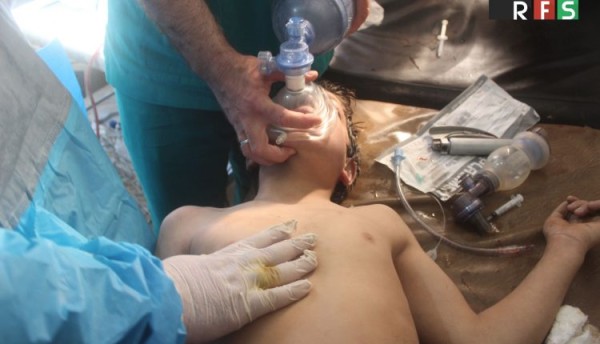UN investigators have confirmed the Assad regime’s sarin attack on the town of Khan Sheikhoun in northwest Syria on April 4.
The report for the UN Human Rights Council said the assault was among 27 chemical attacks by the regime: “Government forces continued the pattern of using chemical weapons against civilians in opposition-held areas. In the gravest incident, the Syrian air force used sarin in Khan Sheikhoun, Idlib, killing dozens, the majority of whom were women and children.”
The Organization for the Prohibition of Chemical Weapons has already found that “sarin or a sarin-like substance” was used on Khan Sheikoun, but its fact-finding mission did not have the authority to assign responsibility.
Multiple witnesses have said a regime Su-22 jet fighter dropped the munition with the nerve agent, amid other conventional airstrikes. Unlike the other bombs, the device with sarin did not explode but landed with a thud as the chemical was released.
Activists said at least 92 people were killed and almost 600 wounded. The UN report says at least 82 deaths have been confirmed, including 28 children and 23 women. Among 293 injured were 103 children.
The UN report on Khan Sheikhoun is based on 43 interviews with eyewitnesses, victims, first responders, and medical workers; satellite imagery,17 photographs of bomb remnants, early warning reports, and videos. It also takes into account the OPCW evidence, including samples from victims, and findings.
The team notes that it sent a note to the regime’s representative in Geneva on April 7 requesting information, but “at the time of writing, no response has been received”.
The report concludes: “The Commission finds that there are reasonable grounds to believe that Syrian forces attacked Khan Shaykhun with a sarin bomb at approximately 6.45 a.m. on 4 April, constituting the war crimes of using chemical weapons and indiscriminate attacks in a civilian inhabited area.”
The Assad regime and its ally Russia have put out a series of contradictory explanations to try and dismiss the incident. Bashar al-Assad has said the attack was “100% fabrication”; however, his agencies gave Khan Sheikhoun samples to the OPCW that verified the presence of sarin. Russia has acknowledged that a chemical was released and that a Su-22 was attacking, but it created the story that the jet fighter hit a “rebel warehouse” with chemical stocks. No evidence of such a warehouse was ever produced, and Moscow’s explanation overlooked that sarin is not active until it is mixed in a munition.
After investigating the multiple regime and Russian claims, the UN report gives a comprehensive rebuttal including no evidence of a rebel weapons depot — with the implication that Russia tried to portray a damaged grain silo as the “wrehouse” — and exposure of the regime Foreign Ministry and Russian Ministry of Defense’s erroneous timings for events.
In addition to its conclusion on the sarin attack, the UN commission documents deliberate airstrikes on the only medical facility in Khan Sheikhoun, as it was treating victims. It notes that the regime and/or Russian warplanes used
“cluster incendiary munition”.
By bombing the al-Rahma medical point, which also destroyed ambulances, Syrian and/or Russian forces committed the war crimes of deliberately attacking protected objects, and intentionally attacking medical personnel and transport.
The team said they had documented 33 chemical weapons attacks, confirmed the 27 by the Assad regime, including seven between March 1 and July 7. They also noted “Syrian and/or Russian forces continued to target hospitals and medical personnel”.
In addition to the assault on Khan Sheikhoun, pro-Assad forces have been using a chemical, probably chlorine, in “toxic gas” attacks in northeast Damascus and nearby suburbs in recent months.
The UN team has not yet identified perpetrators in six of the earliest attacks.

